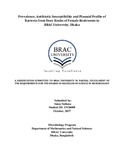| dc.contributor.advisor | Islam, Namista | |
| dc.contributor.author | Sultana, Innas | |
| dc.date.accessioned | 2017-11-19T06:01:12Z | |
| dc.date.available | 2017-11-19T06:01:12Z | |
| dc.date.copyright | 2017 | |
| dc.date.issued | 2017-10 | |
| dc.identifier.other | ID 13126008 | |
| dc.identifier.uri | http://hdl.handle.net/10361/8514 | |
| dc.description | This thesis report is submitted in partial fulfillment of the requirement for the degree of B.Sc in Microbiology, 2017. | en_US |
| dc.description | Includes bibliographical references (page 78-84) | |
| dc.description | Cataloged from PDF version of thesis report. | |
| dc.description.abstract | Non-porous environmental surfaces such as door knobs of restrooms are routinely touched with
hands and can serve as vehicles for transmitting infectious diseases. This study aimed at isolating,
identifying the bacterial contaminants, determining the antibiotic susceptibility pattern of the
isolates to some commonly used antibiotics and investigating plasmid profile of the bacteria
isolated from door knobs of female restrooms in BRAC University, Dhaka, Bangladesh. Fifteen
(15) samples collected through sterile swabs were kept for enrichment into nutrient broth at 37ºC
for 24 hours and were cultured on various selective media the next day. Identification of bacteria
was done through conventional biochemical tests according to Bergey’s Manual of Systematic
Bacteriology. Antibiotic susceptibility test was done by Kirby-Bauer method and plasmid
extraction was done according to modified hot alkaline method. Out of the 15 samples processed,
15 (100%) of them showed bacterial growth. A total of about 37 bacterial isolates were obtained
with Staphylococcus having the highest prevalence 12 (32.43%), followed by Bacillus species 11
(29.73%), E.coli 7 (18.92%), and Micrococcus species 2 (5.41%). Presence of fecal coliform
(13.51%) was also observed in this study. Antibiotic susceptibility pattern of the bacterial isolates
showed that almost all of the isolates were resistant to at least two antibiotics. Among the 37
isolates, 78.38% were found resistant to more than two antibiotics and 21.62% were found resistant
to at least two antibiotics. Highest resistance percentage of the isolates was observed to penicillin
(100%) followed by amoxicillin and rifampicin (75.68%), SXT (48.65%), tetracycline (13.51%),
ciprofloxacin (10.81%), chloramphenicol (8.11%), gentamycin and streptomycin (5.41%).
Plasmid profiling revealed 29.37% (11 out of 37) bacterial isolates contained 1 or more plasmids
with 6 different profiles. A significant proportion of the bacterial isolates (21.63%; 8 out of 37)
carried large plasmids with high molecular weight (> 20 MDa). Six isolates (of 37; 16.22%) carried
large plasmids of approximately 85 MDa size. Findings of this study indicate the presence of multidrug
resistant bacterial strains in door knobs of restrooms which can serve as potential source of
diseases. Regular cleaning of restrooms, use of hand sanitizers, and public awareness on personal
hygiene can help minimize the spread of diseases from door knobs. Among the multi-drug resistant
isolates, three of the isolates contained multiple number of plasmids and eight of the isolates
contained single number of plasmid. Further study on the correlation between antibiotic resistance
and the presence of plasmid would be an interesting line of inquiry. | en_US |
| dc.description.statementofresponsibility | Innas Sultana | |
| dc.format.extent | 104 pages | |
| dc.language.iso | en | en_US |
| dc.publisher | BRAC University | en_US |
| dc.rights | BRAC University thesis are protected by copyright. They may be viewed from this source for any purpose, but reproduction or distribution in any format is prohibited without written permission. | |
| dc.subject | Antibiotic susceptibility | en_US |
| dc.subject | Plasmid | en_US |
| dc.subject | Bacteria | en_US |
| dc.title | Prevalence, antibiotic susceptibility and plasmid profile of bacteria from door knobs of female restrooms in BRAC University, Dhaka | en_US |
| dc.type | Thesis | en_US |
| dc.contributor.department | Department of Mathematics and Natural Sciences, BRAC University | |
| dc.description.degree | B. Microbiology | |

